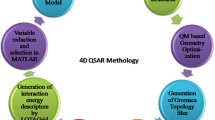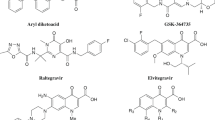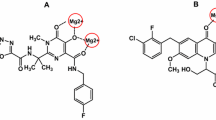Abstract
Human immunodeficiency virus type 1 (HIV-1) integrase is a potential target for anti-HIV therapy. It is an essential enzyme required for replication of the acquired immunodeficiency syndrome (AIDS) virus. Caffeoyl naphthalene sulfonamide derivatives act against HIV integrase and thus have the potential to become a part of an anti-HIV drug regimen. Although caffeoyl naphthalene sulfonamide derivatives have all the features required of good anti-HIV agents such as the presence of bis-catechol moieties, polyaromatic rings, and a central linker, they do  not perform well as anti-HIV agents in cell-based assays, that is, they do not stop viral replication at nontoxic concentration. We carried out a quantitative structure–activity relationship (QSAR) study of caffeoyl naphthalene sulfonamide derivatives via the software WIN CAChe 6.1 and STATISTICA to improve its activity. QSAR reveals that if partition coefficient, connectivity index, and shape index of these molecules are altered, the activity is likely to increase. On the basis of the QSAR model, we designed a new series of compounds, calculated the activities, and found that they were more potent than the existing compounds.
not perform well as anti-HIV agents in cell-based assays, that is, they do not stop viral replication at nontoxic concentration. We carried out a quantitative structure–activity relationship (QSAR) study of caffeoyl naphthalene sulfonamide derivatives via the software WIN CAChe 6.1 and STATISTICA to improve its activity. QSAR reveals that if partition coefficient, connectivity index, and shape index of these molecules are altered, the activity is likely to increase. On the basis of the QSAR model, we designed a new series of compounds, calculated the activities, and found that they were more potent than the existing compounds.

Similar content being viewed by others
References
Carteau S, Mouscadet JF, Goulaouic H, Subra F, Auclair C (1993) Effect of topoisomerase inhibitors on the in vitro HIV DNA integration reaction. Biochem Biophys Res Commun 192:1409
Chen IJ, Neamati N, Nicklaus MC, Orr A, Anderson L, Barchi JJ Jr, Kelly JA, Pommier Y, MacKerell AD Jr (2000) Identification of HIV-1 integrase inhibitors via three-dimensional database searching using ASV and HIV-1 integrases as targets. Bioorg Med Chem 8:2385
Craigie R, Fujiwara T, Bushman F (1990) The IN protein of Moloney murine leukemia virus processes the DNA viral ends and accomplishes their integration in vitro. Cell 62:829
Cushman M, Sherman P (1992) Inhibition of HIV-1 integration protein by aurintricarboxylic acid monomers, monomer analogs, and polymer fractions. Biochem Biophys Res Commun 185:58
De Clercq E (1995) Toward improved anti-HIV chemotheraphy: therapeutic strategies for intervention with HIV infections. J Med Chem 38:2491
Eich E, Pertz H, Kaloga M, Schulz J, Fesen MR, Mazumder A, Pommier Y (1996) (−)-Arctigenin as a lead structure for inhibitors of human immunodeficiency virus type-1 integrase. J Med Chem 39:86
Fesen MR, Kohn KW, Leteurtre F, Pommier Y (1993) Inhibitors of human immunodeficiency virus integrase. Proc Natl Acad Sci USA 90:2399
Hansch C (1969) A quantitative approach to biochemical structure-activity relationships. Acc Chem Res 2:232
Katz RA, Merkel G, Kulkosk T, Leis J, Salka AM (1990) The avian retroviral IN protein is both necessary and sufficient for integrative recombination in vitro. Cell 63:87
Mazumder A, Raghawan K, Weinstein J, Kohn KW, Pommier Y (1995) Inhibition of human immunodeficiency virus type-1 integrase by curcumin. Biochem Pharmacol 49:1165
Mazumder A, Neamati N, Sommadossi JP, Gosseli G, Schinazi RF, Pommier Y (1996) Effects of nucleotide analogues on human immunodeficiency virus type 1 intrgrase. Mol Pharmacol 49:621
Mouscadet JF, Carteau S, Goulaouic H, Subra F, Auclair C (1994) Triplex-mediated inhibition of HIV DNA integration in vitro. J Biol Chem 269:21635
Neamati N (2002) Patented small molecule inhibitors of HIV-1 integrase: a 10-year saga. Expert Opin Ther Patents 12:709
Parril AL (2003) HIV-1 integrase inhibition: binding sites, structure activity relationships and future perspectives. Curr Med Chem 10:1811
Robinson WE Jr, Cordeiro M, Abdel-Malek S, Jia Q, Chow SA, Reineck MG, Mitchell WM (1996a) Dicaffeoylguinic acid inhibitors of human immunodeficiency virus integrase: inhibition of the core catalytic domain of human immunodeficiency virus integrase. Mol Pharmacol 50:846
Robinson WE Jr, Reineck MG, Abdel-Malek S, Jia Q, Chow SA (1996b) Inhibitors of HIV-1 replication inhibit HIV integrase. Proc Natl Acad Sci USA 93:6326
Santo RD, Costi R, Artico M, Tramontano E, Colla PL, Pani A (2003) HIV-1 integrase inhibitors that block HIV-1 replication in infected cells. Planning synthetic derivatives from natural products. Pure Appl Chem 75:195
Xu YW, Zhao GS, Shin CG, Zang HC, Lee CK, Lee YS (2003) Caffeoyl naphtalenesulfonamide derivatives as HIV integrase inhibitors. Bioorg Med Chem 11:3589
Acknowledgment
Kamlesh K. Sahu thanks the All India Council for Technical Education (AICTE), Delhi, India for providing a fellowship to fund this work.
Author information
Authors and Affiliations
Corresponding author
Rights and permissions
About this article
Cite this article
Sahu, K.K., Ravichandran, V., Mourya, V.K. et al. QSAR analysis of caffeoyl naphthalene sulfonamide derivatives as HIV-1 integrase inhibitors. Med Chem Res 15, 418–430 (2007). https://doi.org/10.1007/s00044-006-0020-2
Received:
Accepted:
Published:
Issue Date:
DOI: https://doi.org/10.1007/s00044-006-0020-2




